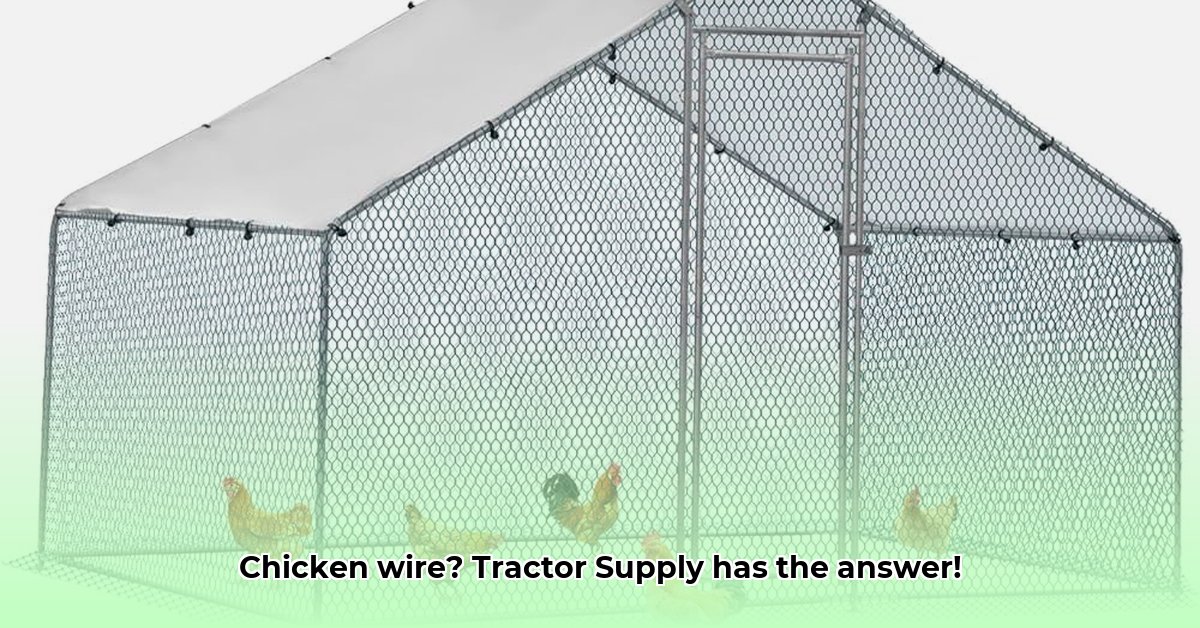
6 ft Chicken Wire Tractor Supply: Your Guide to Building a Sustainable Chicken Run
Building a safe and sustainable chicken run starts with the right materials. Tractor Supply's 6-foot chicken wire is a readily available option, but let's explore how to use it effectively while minimizing environmental impact. Did you know that choosing the right wire can significantly reduce your carbon footprint? For more information on chicken grit from Tractor Supply, check out this helpful resource.
Sizing Up Your Needs: More Than Just Height
Six-foot chicken wire offers decent protection, but predator pressure varies. Hawks, foxes, and other animals may require taller fencing. Consider your local wildlife before settling on a height. Overlooking predator behavior can lead to lost birds and wasted resources.
Beyond the Mesh: Material Matters
The material composition dramatically impacts sustainability. Look for recycled content or biodegradable alternatives. Contact Tractor Supply directly to inquire about their sourcing and manufacturing practices. This proactive step ensures transparency regarding environmental responsibility. Is the chicken wire truly eco-friendly, or is it just marketed that way?
Long-Term Investment: Durability and Lifespan
Durability equals reduced waste. While a slightly higher upfront cost might seem daunting, a longer-lasting wire saves money and reduces environmental impact in the long run. A cheap, quickly rusting wire necessitates frequent replacement, generating more waste. This is particularly crucial when considering sustainable, possibly biodegradable options that may already have higher initial costs.
Building Your Chicken Run: A Step-by-Step Guide
Constructing your chicken run is achievable with these steps:
Planning and Measuring: Accurately measure your intended area, considering terrain variations. Proper planning ensures efficient material use and avoids costly mistakes.
Setting Up Strong Posts: Utilize sturdy posts and space them appropriately to prevent sagging. Post placement directly impacts wire tension and overall fence integrity. (Proper spacing often depends on the wire gauge and the use of bracing wires.)
Securing the Wire: Securely attach the wire with strong staples or wire ties, ensuring a tight, gap-free fence to deter predators. (Using galvanized staples prevents rust and extends fence life).
Adding Extra Support: Reinforce corners and other vulnerable areas to prevent weak points. This will help prevent tears and extend the fence’s life.
Final Check: Meticulously inspect your finished fence for any gaps or weaknesses before introducing your chickens. This final check ensures both their safety and the effectiveness of your work.
Exploring Sustainable Alternatives: The Broader Picture
While Tractor Supply's 6-foot chicken wire is convenient, exploring more sustainable options is crucial for eco-conscious farming. Investigate biodegradable netting or look into repurposing materials—creativity offers numerous sustainable solutions. Is there a way to further minimize your environmental impact?
Weighing the Pros and Cons of 6-Foot Chicken Wire
This table summarizes the advantages and disadvantages:
| Feature | Pros | Cons |
|---|---|---|
| Cost | Affordable and readily available. | Higher long-term cost if it rusts quickly. |
| Availability | Widely available at various retailers. | Sustainability depends on material and manufacturing. |
| Ease of Use | Easy to install. | Prone to rust and degradation, leading to waste. |
| Sustainability | Some options use recycled materials (verify this with the manufacturer). | Non-recycled options contribute to plastic waste. |
Remember, sustainable farming considers the entire material lifecycle. Prioritize "reduce, reuse, recycle" practices whenever feasible.
How to Choose Biodegradable Poultry Netting for Sustainable Farming
Key Takeaways:
- Sustainable poultry farming requires durable, eco-friendly fencing.
- Biodegradable netting minimizes post-use environmental impact.
- Consider strength, longevity, and cost when selecting netting.
- Proper installation and maintenance extend netting lifespan.
- Research biodegradable materials and their properties for informed decision-making.
Understanding Your Needs
Before choosing biodegradable poultry netting, assess your flock size, budget, and local predators. This informs your netting type and quantity, minimizing waste. “Sustainable” must also include efficient resource management.
Types of Biodegradable Poultry Netting
Several biodegradable options exist:
- Plant-based plastics: Made from renewable resources, breaking down naturally.
- Compostable netting: Designed for commercial composting facilities (check certifications).
- Natural fibers: (hemp, etc.) – Biodegrade but may have limited availability.
Remember: Biodegradation varies; check manufacturer specifications for breakdown times.
Evaluating Biodegradable Netting
Consider:
- Strength and Durability: Ensure it withstands weather, predators, and your birds.
- Mesh Size: Balance predator protection with air circulation.
- UV Resistance: Select netting resistant to sunlight degradation.
- Cost: Balance initial cost with long-term environmental benefits.
Installation & Maintenance
Proper installation maximizes lifespan:
- Secure fencing using sturdy posts and tensioning wires.
- Bury the bottom edge to prevent digging predators.
- Regularly inspect and repair any damage promptly.
Prompt repairs extend the lifespan of even biodegradable options.
Where to Find Biodegradable Poultry Netting
Online retailers and agricultural supply stores increasingly offer biodegradable options. Contact manufacturers directly for detailed material composition and breakdown time information.